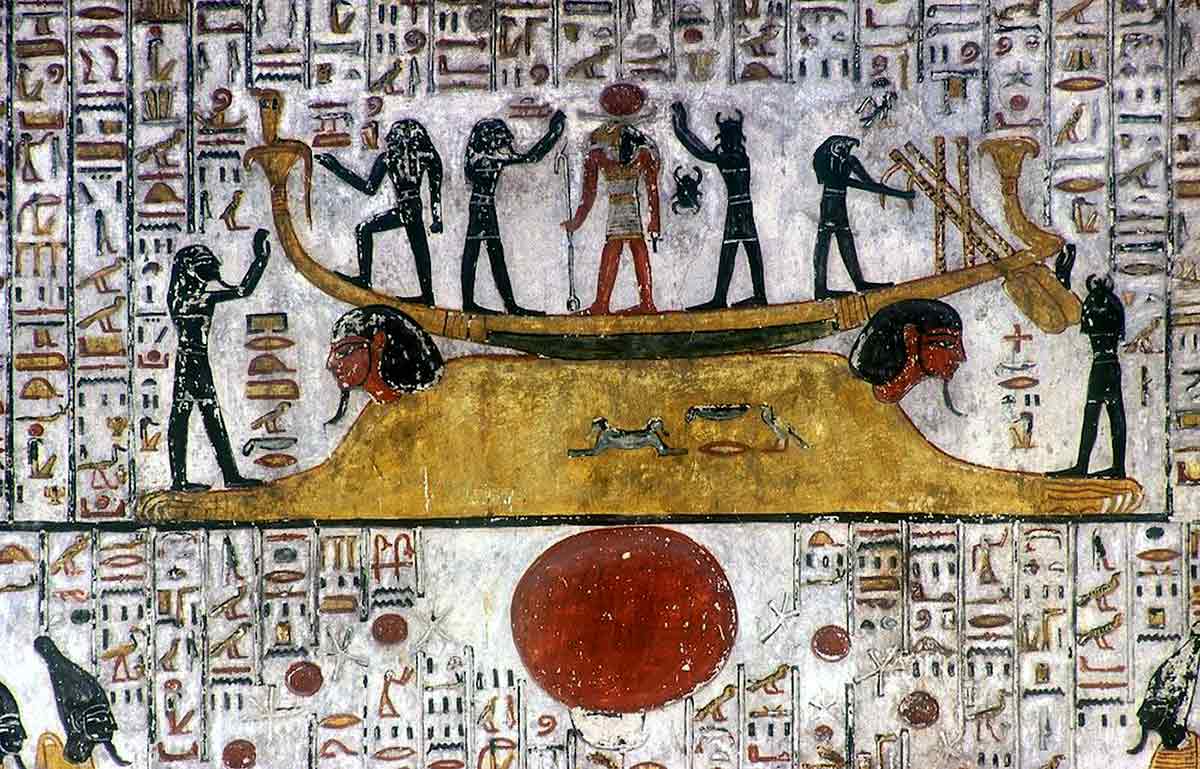
The almighty sun god Ra (or Re) was an enduring deity in the pantheon of ancient Egypt, who remains a subject of fascination amongst scholars today. King of the deities and father of creation, he was the most sacred of all the gods, a solar deity who embodied the sheer power of the sun and gave life to the universe. As such, he symbolized the great reverence ancient Egyptians had for the sun as an agricultural society in the desert whose lives revolved around growth and regeneration.
One of oldest deities in the Egyptian pantheon, Ra’s human form typically had the head of a falcon, on which the sun disc rested, sometimes encircled by a sacred cobra named Uraeus. However, the sun god Ra took a variety of other forms including a scarab beetle, a ram, a man, and even the sun itself, throughout the evolution of ancient Egyptian civilization.
Ra Spawned All Life

According to many Egyptian myths, sun god Ra was responsible for the creation of all life. Out of eternal darkness, an entity called Atum called forth the beginning of creation. An island slowly emerged out of the Primeval Ocean, which turned into Ra, the sun god. Ra spawned the first gods, Shu, god of the air, Tefnut, god of humidity, along with Geb, the earth god, and Nut, the sky goddess. Geb and Nut birthed Osiris, the Perfect Being, who became ruler of the world. Ra created the elements, and produced humans from the tears of his eyes. As creator of the universe, Ra became father and king to all gods, humans and living creatures.
Ra Journeyed Through the Sky

Get the latest articles delivered to your inbox
Sign up to our Free Weekly NewsletterEgyptians believed that it was Ra’s duty to travel across the sky every day, bringing light and life to the world. As the sun set, Ra would descend into the underworld, where he battled against forces of darkness, including the evil serpent Apopis, in order to ensure the sun could rise again in the morning. Egyptians likened this daily pattern of light and darkness to the entire cycle of life, in which humans live, die and rise again in the afterlife.
He Punished Mankind

In one of Ra’s originary myths, he discovered that mankind was plotting to overthrow him. When Ra saw how destructive and disobedient mankind had become, he sent his eye in the form of Hathor, (or Sekhmet), to dish out a harsh punishment. She took the form of a lioness and raged across the earth on a killing spree, almost wiping out the entire human race. Ra was forced to intervene, tricking the goddess into getting drunk so she could no longer inflict harm. In this way Ra first introduced death to the world, asserting his almighty power over the people.
The Eye of Ra

Not to be confused with Ra himself, the eye of Ra was the god’s feminine counterpart, sometimes described as his daughter, wife, or mother. The eye was a potent extension of Ra’s power which was associated with several different goddesses including Bastet, Ma’at, and Sekhmet, each of whom had a protective role in keeping Ra safe from external evil forces. It was their role to preserve his royal authority, sometimes through violent means.
He Had a Secret Name

Legend had it Ra held a secret name within him that held the key to his power. In one myth, Isis, goddess of magic, healing and motherhood, tricked Ra into revealing his name by making him so ill from a venomous snake bite, that he had no choice but to surrender it. He thus giving away a core part of himself to her. Isis used Ra’s power to protect her son Horus, and eventually transferred the power to Horus so he could take up the throne following Ra’s retirement. While Isis ensured her son’s future, she also made enemies out of Ra’s most devoted followers.
He Later Merged with Other Gods

In later mythologies Ra was merged with several other deities to assume different forms and attributes. When merged with Amun, an unknowable creator deity, Ra became Amun-Ra, radiating the primal power of the sun. In his associations with Horus, the god of the sky, Ra became Ra-Horakhty, sometimes known as “Ra Horus in the horizon.”








